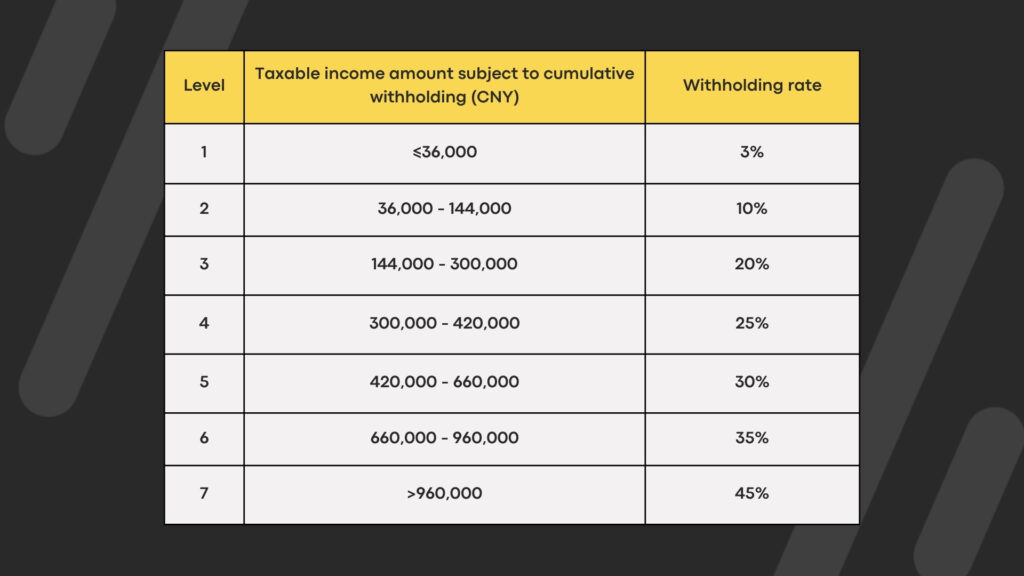Navigating the complexities of payroll taxes in China is an integral part of doing business in this country. It’s essential for companies—both domestic and foreign—to fully grasp the structure of China’s tax system. The country’s payroll tax system is multifaceted, consisting of various components, like income taxes, mandatory contributions for social welfare and many more. These taxes are not just a regulatory obligation; they represent a very important part of the nation’s social safety net, supporting public services like healthcare, pensions, and housing.
In China, payroll taxes encompass a range of mandatory contributions for social welfare programs, alongside individual and enterprise income taxes. Both employers and employees contribute to social security funds, but the employer bears a greater portion of the burden. The government sets precise contribution rates based on an employee’s gross salary, and companies must remit these taxes monthly. The system is centralized, but enforcement and rates can vary slightly by region.
Common Payroll Taxes in China
Income Tax
Income tax in China is levied on the global income of individuals who reside in the country for more than 183 days a year. It applies to salaries, wages, and bonuses. For expatriates, double taxation treaties can mitigate the tax burden. The country uses a progressive tax system, meaning the rate increases as income rises.
Individual Income Tax
Individual income tax (IIT) is the most well-known payroll tax in China. The rates range from 3% to 45%, depending on income brackets, with seven progressive levels. For employees earning between CNY (Chinese Yuan) 1,500 to CNY 12,000 per month, the tax burden is moderate but becomes substantial for higher earners.

IIT Withholding Rates Table for Resident Individuals, per China Briefing.
Enterprise Income Tax
Though not typically thought of as a payroll tax, Enterprise Income Tax (EIT) influences payroll decisions, especially in terms of how companies structure employee compensation. EIT is levied at 25% on a company’s taxable income and plays a role in dictating overall financial planning, including payroll expenditures.
Social Security Contributions
China’s social security system comprises several funds designed to protect employees from life’s uncertainties. Both employers and employees must contribute, with the employer shouldering the majority of the costs.
Pension Fund
The pension fund in China is a mandatory contribution aimed at ensuring financial stability for workers after retirement. Employers contribute 16-20% of the employee’s salary, while employees contribute around 8%. Contributions are cumulative, meaning that expatriates can sometimes reclaim their contributions when leaving China.
Medical Care Fund
China’s medical care fund is another significant payroll tax element. Employers contribute between 6-10% of salaries, while employees contribute around 2%. This fund guarantees employees access to essential healthcare services, which is especially critical in a country with a rapidly aging population.
Unemployment Insurance Fund
Unemployment insurance provides financial assistance to workers who lose their jobs. Employers contribute 0.5-1% of the payroll, while employees contribute 0.2-0.5%. Though the unemployment rate in China remains low, this fund ensures a social safety net for those affected by layoffs or economic downturns.
Work Injury Insurance Fund
This fund compensates employees who suffer work-related injuries. Contributions vary by industry, reflecting the risks inherent in different jobs. High-risk sectors such as construction pay higher rates, typically ranging from 0.5% to 2% of the employee’s salary.
Maternity Insurance Fund
Maternity insurance covers the costs of childbirth and provides maternity leave benefits. Employers contribute between 0.5% to 1% of the employee’s salary, ensuring that female workers receive financial support during pregnancy and childbirth.
Housing Provident Fund
The Housing Provident Fund helps employees purchase homes or pay for housing-related expenses. Both the employer and employee contribute equally, usually around 5-12% of the employee’s monthly salary. This fund has gained importance as housing prices in China have surged in recent years.
Calculating and Paying Payroll Taxes
Payroll tax calculations in China can be complex due to the various tax bands and social security contributions. Employers need to carefully calculate each employee’s income and deduct the appropriate amount based on their earnings. Typically, gross salary serves as the baseline for these calculations, but allowances, bonuses, and commissions also factor in.
Note!
Payroll taxes are generally due by the 15th of the following month. Failure to meet this deadline can result in significant penalties, making timely remittance crucial for businesses.
Foreign Companies Operating in China
Withholding Tax
For foreign companies, withholding tax on payments made to overseas entities is another aspect of payroll taxes that cannot be overlooked. This tax applies to dividends, interest, royalties, and other forms of income, typically at rates between 10-20%.
Double Taxation Agreements (DTA´s)
To mitigate the impact of being taxed both in China and the foreign investor’s home country, China has established double taxation agreements (DTAs) with over 100 countries. These agreements allow companies to offset their tax liabilities, making cross-border business operations more feasible.
Note!
Given the complexity of China’s payroll tax system, many foreign companies opt to outsource their payroll operations to local service providers. Outsourcing reduces the administrative burden, ensures compliance with local laws, and minimizes the risk of penalties. These services often include tax filing, employee contributions, and regulatory reporting.
Understanding and managing payroll taxes in China is essential for businesses of all sizes. With proper planning, compliance, and expertise, companies can navigate the intricacies of the system, ensuring smooth operations while fulfilling their legal obligations.
Thinking of Expanding You Business to China? Agile HRO can be your right hand!
Get Started with Agile
Schedule a 30-minute product demo with Q&A